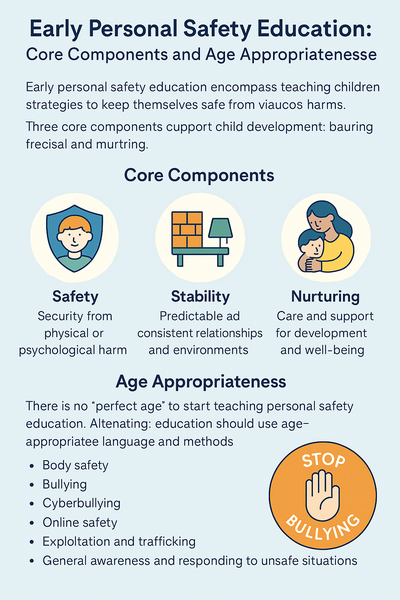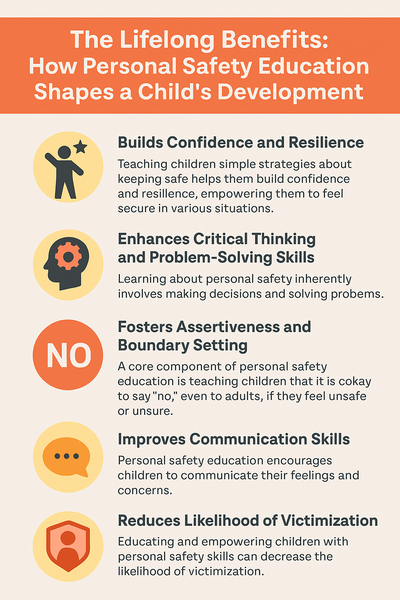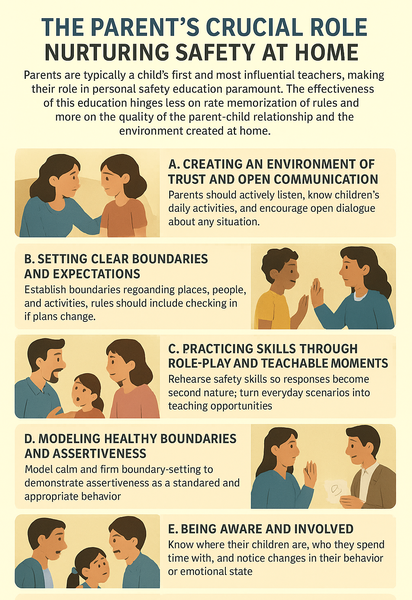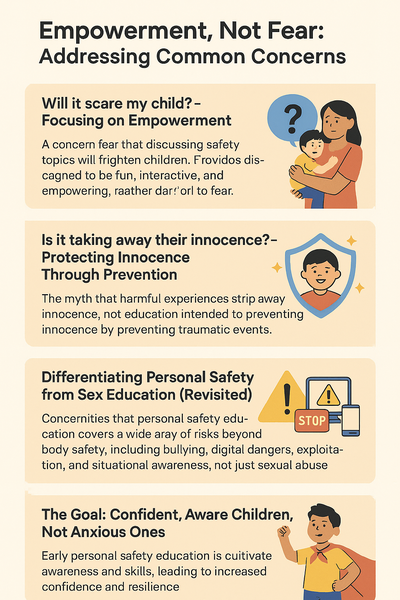Empowering Kids: Why Early Personal Safety Education Matters

Discover the importance of early personal safety education for children. Learn how to teach body autonomy, safe boundaries, and confidence-building strategies to help kids protect themselves in real-world situations.
Introduction
The well-being of children is a paramount concern for any society. While we strive to create safe environments, the unfortunate reality is that children can face various risks. Statistics indicate that a significant number of children may experience some form of victimization before reaching adulthood. This underscores the critical need for proactive measures. Early personal safety education is not about instilling fear; it is about equipping children with the knowledge, skills, and confidence to recognize and respond to potentially unsafe situations. It is a proactive investment in their current and future well-being, moving beyond a reactive stance taken only after harm has occurred. For more insights into fostering child development, you can explore our blog.
What is Early Personal Safety Education? Core Components and Age Appropriateness

Early personal safety education encompasses teaching children strategies to keep themselves safe from various harms. The Centers for Disease Control and Prevention (CDC) has developed the Essentials for Childhood (EfC) framework, which posits that optimal child development hinges on a foundation of safe, stable, and nurturing relationships and environments. These core components are defined as:
- Safety: The extent to which a child is secure from physical or psychological harm within their social and physical environments.
- Stability: Healthy relationships and environments that are predictable and consistent.
- Nurturing: The provision of care and support that promotes a child's development and well-being.
There is no single "perfect age" to begin teaching personal safety; a child's ability to comprehend and practice safety skills is influenced by their age, educational level, and developmental stage. However, foundational concepts can be introduced to very young children and then built upon as they mature. For instance, simple ideas about body ownership can be taught to preschoolers, while older children can engage with more complex topics like online safety and peer pressure. It is crucial to use age- and developmentally-appropriate language and methods. Understanding child developmental milestones can help tailor these conversations.
It is also important to differentiate personal safety education from sex education. While body safety and understanding appropriate touches are components of personal safety, the overall scope is much broader. Personal safety education addresses a wide array of potential threats, including bullying, cyberbullying, digital dangers, exploitation, and trafficking, alongside general awareness and responding to unsafe situations. The focus is on empowering children with comprehensive skills to navigate various aspects of their world safely.
The Lifelong Benefits: How Personal Safety Education Shapes a Child's Development

Introducing personal safety concepts early offers a multitude of benefits that extend far beyond immediate protection, contributing significantly to a child's overall development and shaping them into more resilient and capable individuals.
- Builds Confidence and Resilience: Teaching children simple strategies about keeping safe helps them build confidence and resilience, empowering them to feel secure in various situations. When children understand how to stay safe, they feel more confident in their abilities to make decisions and protect themselves. This increased sense of confidence, in turn, enhances their resiliency.
- Enhances Critical Thinking and Problem-Solving Skills: Learning about personal safety inherently involves making decisions and solving problems. This process enhances children's critical thinking and decision-making skills. They learn to assess situations, consider potential outcomes, and choose safer courses of action. You might find our article on unlocking your child's potential with brain-boosting activities relevant here.
- Fosters Assertiveness and Boundary Setting: A core component of personal safety education is teaching children that it is okay to say "no," even to adults, if they feel unsafe or unsure. This helps them develop assertiveness and understand the importance of personal boundaries. Learning to articulate their discomfort and set limits is a crucial life skill. The ability to say "NO" in uncomfortable or uncertain situations can be the difference between victimization and safety.
- Improves Communication Skills: Personal safety education encourages children to communicate their feelings and concerns. They learn the importance of speaking out if they feel unsafe and telling a trusted adult. This not only aids in immediate safety but also fosters better overall communication habits. Effective programs have demonstrated a noticeable improvement in how children communicate and approach safe adults to share concerns. For tips on talking with older children, see our post on meaningful conversations with your teen.
- Reduces Likelihood of Victimization: Research shows that educating and empowering children with personal safety skills can decrease the likelihood of victimization. This is achieved by improving their ability to recognize and respond safely to dangerous situations, increasing their ability to resist potential offenders, deterring offenders who prey on vulnerable children, and increasing the likelihood they will communicate with safe adults about unsafe situations.
These developmental benefits highlight that personal safety education is not merely a set of rules but a foundational element of a child's growth, equipping them with tools that will serve them throughout their lives.
Key Topics to Cover in Early Personal Safety Education

A comprehensive personal safety curriculum addresses several crucial areas, tailored to be age-appropriate and understandable for children.
- Body Ownership ("My Body Belongs to Me"): This foundational concept teaches children that they have autonomy over their own bodies. For younger children, this means explaining that their body belongs to them and they have the right to decide who touches them and how. Using correct anatomical terms for body parts is also encouraged, as this can make children more at ease if they need to disclose an uncomfortable touch and prevents disclosures from being missed due to ambiguous language.
- Understanding Safe and Unsafe Touches: Children need to learn to distinguish between touches that are acceptable and those that are not. This involves discussing that some touches are friendly, while others can be hurtful or simply unwelcome, even if they don't cause physical pain. The focus should be on how a touch makes them feel; if it makes them feel scared, uncomfortable, or confused, it's an unsafe touch, and they should report it.
- Identifying Trusted Adults: Children should be able to identify several trusted adults in their lives to whom they can turn if they feel unsafe, scared, or have a problem. These adults could be parents, teachers, or other close family members. It's important to reinforce that these adults will listen and help them.
- The "No, Go, Tell" Strategy (or similar frameworks): Many programs use simple, memorable strategies. For example, the MBF 5 Safety Rules© help children recognize unsafe situations and know how to respond. A common framework involves teaching children to:
- Say "NO" assertively if they feel unsafe or uncomfortable.
- "GO" away from the situation or person if possible.
- "TELL" a trusted adult what happened.
- Secrets vs. Surprises: It's vital to teach children the difference between good surprises (like a birthday party, which are meant to be revealed and bring happiness) and secrets that make them feel uneasy or are requested by someone to be kept hidden indefinitely, especially from trusted adults. Children should understand that no one should ask them to keep a secret that makes them feel uncomfortable, and that nothing is so "yucky" they can't tell a trusted adult about it.
- Online Safety Basics: In today's digital age, online safety is an indispensable part of personal safety education. Children need to learn rules about:
- Not sharing personal information (name, address, phone number, school) online.
- Not sharing photos with strangers online.
- Never meeting an online acquaintance in person without a parent's supervision and consent.
- Understanding that people online may not be who they say they are. For more on this, consider our guide on tech-savvy parenting and navigating the digital age safely.
- Stranger Awareness (Nuanced Approach): While "stranger danger" is a common refrain, education should be nuanced. Instead of teaching children to fear all strangers, the focus can be on identifying unsafe situations or behaviors, regardless of whether the person is known or unknown. Children should learn that adults generally do not ask children for help or directions, and such approaches could be a "trick". They should also learn the "Check First" rule: before going anywhere, taking anything, or accepting an invitation from anyone (stranger or someone they know), they should check with a trusted adult. Our article, "(beyond stranger danger the ultimate guide to teaching kids personal safety ) delves deeper into this topic.
These topics, when taught consistently and in an age-appropriate manner, provide children with a robust toolkit for navigating potential risks.
The Parent's Crucial Role: Nurturing Safety at Home

Parents are typically a child's first and most influential teachers, making their role in personal safety education paramount. The effectiveness of this education hinges less on rote memorization of rules and more on the quality of the parent-child relationship and the environment created at home.
- A. Creating an Environment of Trust and Open Communication The cornerstone of teaching personal safety is fostering an environment where children feel safe to talk about anything without fear of judgment or punishment. Parents should actively listen to their children, know their daily activities, and encourage open dialogue about any situation. It's vital to reassure children that their safety is the number one concern and that they will be believed if they report something. If a child does disclose something troubling, parents should strive to remain calm, non-critical, and non-judgmental. A child's willingness to share is directly linked to how they anticipate their parents will react. Thus, a foundation of trust and open communication is the most critical element parents can provide, creating the context within which specific safety skills are taught and absorbed. Explore parenting hacks for building strong bonds for more ideas.
- B. Setting Clear Boundaries and Expectations Establishing clear boundaries regarding places children may go, people they may see, and activities they may engage in provides a framework of safety and predictability. These rules should include checking in with parents if plans change. Such boundaries help children understand what is expected and what is off-limits, contributing to their sense of security.
- C. Practicing Skills Through Role-Play and Teachable Moments Safety skills, like any other skill, become more ingrained with practice. Parents should rehearse safety skills with their children so responses become second nature. Everyday situations, such as a visit to the mall, reading a story, or even a sibling disagreement, can be transformed into "teachable experiences". Role-playing various scenarios, like how to respond to a stranger or someone making them feel uncomfortable, helps children feel more prepared and less likely to freeze in a real situation. This practice builds a kind of "muscle memory" for safe responses.
- D. Modeling Healthy Boundaries and Assertiveness Children are keen observers and learn significantly by watching the adults around them. When parents model setting their own personal boundaries in a calm and firm manner, it demonstrates to children that this is a normal and necessary behavior. If a child witnesses a parent respectfully declining an unwanted invitation or clearly stating their discomfort, it provides a real-life script, making it more likely the child will emulate these actions when facing their own boundary challenges. This is a powerful form of "showing" rather than just "telling." Our article on how adult behavior shapes child development offers further insights.
- E. Being Aware and Involved Parental vigilance is a key protective factor. Knowing where children are at all times is fundamental. It's also important for parents to pay attention to who their child spends time with and to be alert to any unusual attention or gifts from others. Noticing changes in a child's behavior or emotional state can also be an indicator that something is amiss. Being attuned to a child's life can help identify potential risks or signs of distress early.
- F. Teaching Specific Safety Rules for Different Contexts General safety principles need to be applied to specific environments. Parents should teach rules for:
- Safety at Home: This includes knowing emergency contact information, rules about not opening the door to strangers, and age-appropriate guidelines for using appliances or tools.
- Safety in the Neighborhood: This involves defining geographical boundaries, specifying whose homes they are permitted to visit, and rules against going off alone.
- Safety at School: Discussing safe routes to and from school, and cautioning against displaying names prominently on belongings (which might allow a stranger to feign familiarity) are important. Context-specific rules help children understand how to apply broader safety knowledge in the various environments they navigate daily. Furthermore, the idea of "teachable moments" suggests that personal safety education should be an ongoing dialogue integrated into daily life, rather than a single, formal lecture. This approach makes learning more organic, less intimidating, and allows for continuous reinforcement and adaptation as the child grows and encounters new situations, making it a natural part of their upbringing. For related information, check out our first aid fundamentals every parent should know.
Beyond the Home: Schools and Communities as Safety Allies

While parents are primary educators, the responsibility for children's safety extends into the wider community, particularly schools, where children spend a significant portion of their day. A collaborative ecosystem involving parents, schools, and the community creates a more robust safety net.
- A. The School's Role: Creating Safe Environments and Integrated Learning Schools play a vital role by providing safe, stable, and nurturing relationships and environments. This encompasses several dimensions:
- Physical Safety: This includes ensuring security measures are in place, maintaining a clean and well-kept school environment, providing safe access to the school, and having emergency preparedness plans.
- Emotional Safety: A crucial aspect involves actively addressing bullying and harassment, fostering emotional intelligence, promoting respect for diversity, and cultivating an overall school climate that values students, staff, and parents. A child who feels emotionally unsafe is less likely to learn effectively or report other safety concerns.
- Open Communication: Establishing channels for open communication between the school, students, and parents is essential for a positive and safe school climate.
- Curriculum Integration: Personal safety education can and should be integrated into the school curriculum in developmentally appropriate ways. Programs like MBF Child Safety Matters® are designed for school settings and teach children vital safety rules. This aligns with broader goals of early education success.
- The Educator's Role: Educators are uniquely positioned to reinforce safety messages. Their responsibilities include recognizing signs of abuse and knowing the correct reporting procedures, teaching children about assertiveness, body ownership, and the rules about secrets, creating a classroom environment where children feel comfortable confiding in them, and collaborating with parents to ensure consistent messaging.
- B. Community Support Systems and Collective Responsibility Child protection is not solely the responsibility of parents or schools; it is a shared community effort. Communities can contribute by:
- Offering workshops and educational materials on child abuse awareness and prevention for parents and community members.
- Providing safe spaces and supervised activities, such as after-school programs and mentorship opportunities.
- Fostering a neighborhood culture where there is collective responsibility for the well-being of children. Supportive community structures can act as a buffer against negative environmental forces that might otherwise overwhelm even well-intentioned parents, providing resources, education, and safe havens.
- C. The Importance of Consistent Messaging Across Environments Children benefit immensely when they receive consistent safety messages from all the key adults and institutions in their lives—parents, educators, and community members. When a child hears the same core principles about their rights, their body, and how to seek help from multiple trusted sources, the message is significantly reinforced and more likely to be internalized. This consistency reduces confusion and strengthens the child's understanding and application of safety skills. This implies a need for ongoing communication and partnership between families, schools, and community organizations to ensure a unified approach to child safety.
Empowerment, Not Fear: Addressing Common Concerns

When considering personal safety education, parents and caregivers often have understandable concerns. Addressing these directly is key to fostering acceptance and implementation of these vital programs. You can find answers to common parenting questions in our FAQ section.
- A. "Will it scare my child?" – Focusing on Empowerment A common fear is that discussing safety topics will frighten children. However, modern, age-appropriate personal safety programs are specifically designed to be fun, interactive, and empowering, rather than dark or scary. The goal is not to make children fearful, but to equip them with tools and knowledge that build their confidence to navigate the world safely. Educating parents about these empowerment-based approaches can alleviate their anxieties.
- B. "Is it taking away their innocence?" – Protecting Innocence Through Prevention Another prevalent myth is that safety education might rob children of their innocence. The counter-argument is powerful and accurate: it is harmful experiences that take away a child's innocence, not education designed to prevent such experiences. This perspective reframes safety education as a protective measure that actively works to preserve innocence by reducing the likelihood of traumatic events. It challenges the notion that ignorance equates to protection.
- C. Differentiating Personal Safety from Sex Education (Revisited) It bears repeating that while body safety is an integral component, personal safety education encompasses a much broader range of risks. These include bullying, cyberbullying, digital dangers, exploitation, and general situational awareness, not solely topics related to sexual abuse. Clarifying this distinction helps address potential misconceptions and ensures a fuller understanding of the program's scope.
- D. The Goal: Confident, Aware Children, Not Anxious Ones The ultimate aim of early personal safety education is to cultivate awareness and skills that lead to increased confidence and resilience, not to make children hyper-vigilant or perpetually anxious about the world around them. The objective is to empower children with the ability to recognize potential dangers and know how to respond effectively, thereby feeling more secure and capable. Successfully addressing these common parental concerns is crucial for the widespread adoption and ultimate effectiveness of personal safety programs, as parental buy-in is essential for children's learning and well-being.
Conclusion: Raising a Generation of Confident, Aware, and Safe Children
Early personal safety education is far more than a series of lessons; it is a fundamental investment in a child's immediate safety and their long-term well-being. The knowledge and skills imparted—ranging from understanding body ownership and setting boundaries to recognizing unsafe situations and seeking help—are not temporary fixes but foundational tools that can stay with them throughout adulthood. These lessons become the bedrock for developing into responsible, aware, and resilient individuals.
The ultimate goal extends beyond the mere prevention of harm; it contributes to the development of well-adjusted and empowered human beings. Skills such as assertiveness, critical thinking, boundary setting, and effective communication are invaluable in all facets of life, fostering positive mental health and social competence. Thus, personal safety education is an integral part of holistic child development. For more on parenting with purpose, explore our resources.
The responsibility for this crucial education is shared. Parents, caregivers, educators, and the wider community all have a role to play in starting these vital conversations, using age-appropriate language, and consistently reinforcing safety principles. It is not a one-time lecture but an ongoing dialogue that adapts to a child's evolving developmental stages and life experiences. This dynamic approach ensures that safety education remains relevant and effective as children grow and encounter new challenges.
By embracing and implementing early personal safety education, we can collectively work towards a future where children are not only protected but also feel confident, capable, and empowered to navigate the world safely—becoming "smart, strong, and safe" individuals.
FAQs About Early Personal Safety Education for Children
- Question:
Why is it important to teach children personal safety at an early age? - Answer:
Early personal safety education helps children develop body awareness, set boundaries, and build confidence. Teaching kids about safe and unsafe behaviors early empowers them to protect themselves, speak up, and understand their rights. It also lays the foundation for lifelong confidence and resilience. - Question:
What are some key topics to cover in personal safety education for young children? - Answer:
Important topics include body autonomy, understanding safe vs. unsafe touch, the correct names for body parts, saying “no” with confidence, identifying trusted adults, and recognizing dangerous situations like "stranger danger" or inappropriate behavior—even from known people. - Question:
How can parents teach personal safety without creating fear? - Answer:
Use age-appropriate language and a calm, supportive tone. Focus on empowering rather than scaring children. Role-playing scenarios, storytelling, and using trusted books or videos can help kids grasp safety concepts in a non-threatening way. - Question:
When should parents start talking about personal safety? - Answer:
It’s ideal to start by age 2 or 3 using simple concepts like private parts, personal space, and saying “no.” As kids grow, introduce more detailed lessons in a way that’s developmentally appropriate. Consistent, open dialogue ensures they understand and feel safe asking questions. - Question:
What role does body autonomy play in child safety? - Answer:
Teaching body autonomy shows kids that they have control over their bodies and that no one should touch them without consent. This awareness encourages kids to speak up about uncomfortable experiences and builds their confidence in asserting boundaries. - Question:
Are there any tools or resources to help teach kids about personal safety? - Answer:
Yes! Picture books, animated videos, safety games, and workshops are great tools. Also, check out platforms like KidyPulse NutriAI, which shares expert parenting tips and development guides—including strategies to teach kids emotional and physical safety effectively.
Sources used in this blog :
Protecting Our Kids: Teaching Children About Personal Safety
How to Teach Kids About Personal Safety and Boundaries - Bryan
Teaching Children Personal Safety | Bravehearts
Why Your Child Needs Personal Safety Education... - Monique Burr
Conceptualizing and Measuring Safe, Stable, Nurturing Relationships and Environments in Educational Settings - PMC - PubMed Central
What does personal safety mean for kids? | Walkertown Academy
Personal Safety Theme For Preschoolers - Aussie Childcare Network
Child Abuse Prevention - Elements of Prevention - Safe Kids Thrive
The Role of Educators in Child Abuse & Neglect Prevention - The Kempe Foundation
Teaching Kids About Personal Safety and Awareness with 'Safety First' - Bethany High
The importance of teaching safety and awareness in public settings
Essential Tips for Ensuring Child Safety at Home - Mother's Pet Kindergarten
The Role of Community in Child Protection: Creating a Safer Environment for Children
Creating Community Responsibility for Child Protection: Possibilities and Challenges - PMC
Parent's Role in Keeping Children Safe | Rialto, CA

Comments
No comments yet. Be the first to leave a comment!